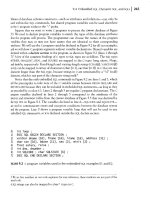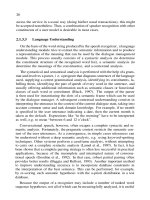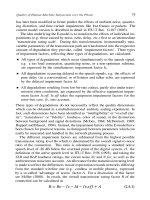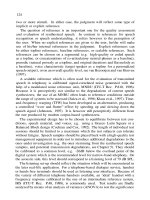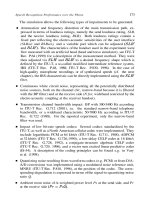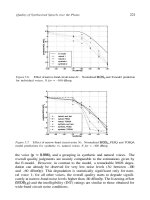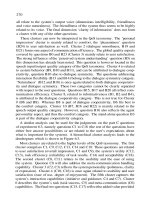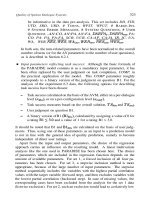Quality of Telephone-Based Spoken Dialogue Systems phần 8 pdf
Bạn đang xem bản rút gọn của tài liệu. Xem và tải ngay bản đầy đủ của tài liệu tại đây (4.21 MB, 48 trang )
Quality of Spoken Dialogue Systems
323
be informative in the data pre-analysis. This set includes DD, STD,
UTD, SRD, URD, # T
URNS
, WPST, WPUT, # BARGE-INS,
# SYSTEM ERROR MESSAGES, # SYSTEM QUESTIONS, # USER
Q
UESTIONS
,
AN:CO,
AN:PA,
AN:FA,
PA:
CO, PA: PA, PA:FA, SCR, UCR, CA:AP, CA:IA, IR, IC, UA,
WA,
WER,
In both sets, the turn-related parameters have been normalized to the overall
number of turns (or for the AN parameters to the number of user questions),
as is described in Section 6.2.1.
Input parameters reflecting task success: Although the basic formula of
the PARADISE model contains as a mandatory input parameter, it has
been often replaced by the user judgment on task completion, COMP, in
the practical application of the model. This COMP parameter roughly
corresponds to a binary version of the judgment on question B1. For the
analysis of the experiment 6.3 data, the following options for describing
task success have been chosen:
Task success calculated on the basis of the AVM, either on a per-dialogue
level or on a per-configuration level
Task success measures based on the overall solution, and
User judgment on question B1.
A binary version of B1 calculated by assigning a value of 0 for
a rating and a value of 1 for a rating B1 > 3.0.
It should be noted that B1 and are calculated on the basis of user judg-
ments. Thus, using one of these parameters as an input to a prediction model
is not in line with the general idea of quality prediction, namely to become
independent of direct user ratings.
Apart from the input and output parameters, the choice of the regression
approach carries an influence on the resulting model. A linear multivariate
analysis like the one used in PARADISE has been chosen here. The choice
of parameters which are included in the regression function depends on the
amount of available parameters. For set 1, a forced inclusion of all four pa-
rameters has been chosen. For set 2, a stepwise inclusion method is more
appropriate, because of the large number of input parameters. The stepwise
method sequentially includes the variables with the highest partial correlation
values with the target variable (forward step), and then excludes variables with
the lowest partial correlation (backward step). In case of missing values, the
corresponding cases have been excluded from the analysis for the set 1 data
(listwise exclusion). For set 2, such an exclusion would lead to a relatively low
324
number of valid cases; therefore, the missing values have been replaced by the
corresponding mean value instead.
In Table 6.35, the amount of variance covered by models with set 1 input
parameters is listed for different target variables and task-success-related input
parameters. When the coefficient is used for describing task success, the
amount of covered variance is very low Unfortunately,
the authors of PARADISE do not provide example models which include the
coefficient. Instead, their models rely on the COMP measure. Making use of
the parameter (which is similar to COMP
)
increases to 0.24 0.45,
which is in the range of values given in the literature. The model’s performance
can be further increased by using the non-simplified judgment on question B1
for describing task success. In this case, reaches 0.52, a value which is
amongst the best of Table 6.34. Task success measures which are based on the
overall solution and the modified version provide slightly better
estimations than and but they are not competitive with the subject-
derived measures B1 and Apparently, the PARADISE model performs
best when it is not completely relying on interaction parameters, but when
subjective estimations of task success are included in the estimation function.
This finding is in line with comparative experiments described by Bonneau-
Maynard et al. (2000). When using subjectivejudgments of task success instead
of the coefficient, the amount of predicted variance raised from 0.41 to 0.48.
Comparing the performance for the different target variables, seems to
be least predictable. The amount of covered variance is significantly lower than
in the experiments described by Walker. The relatively low number of input
parameters in set 1 may be a major reason for this finding. Prediction accuracy
significantly raises when B0 or B23 are taken as the target parameter, and with
B1 or describing task success. A further improvement is observed when
Quality of Spoken Dialogue Systems
325
the target parameter is calculated as a mean over several ratings, namely as
M
EAN(B0, B23) or MEAN(B). The model’s performance is equally high
in these cases. Apparently, the smoothing of individual judgments which is
inherent to the calculation of the mean has a positive effect on the model’s
prediction accuracy.
Table 6.36 shows the significant predictors for different models determined
using the set 1 “dialogue cost” parameters and different task-success-related
parameters as the input
.
Target variables are either the
or the MEAN
(B
)
parameter. For most significant dialogue cost contributions come from
# T
URNS (with a negative sign), and partly also from the # BARGE-INS pa-
rameter (negative sign). DD and IC only play a subordinate role in predicting
For the task-success-related parameters, a clear order can be observed:
B1 and have a dominant effect on (both with a positive sign),
and only a moderate one (the first with a positive and the second with a
326
negative sign), and and are nearly irrelevant in predicting For
M
EAN(B) as the target, the situation is very similar. Once again, # TURNS is a
persistent predictor (always with a negative sign), and DD, IC and # B
ARGE-
I
NS only have minor importance. The task-success-related input parameters
show the same significance order in predicting M
EAN
(B): B1 and have
a strong effect (positive sign), and a moderate one (also posi-
tive sign), and and are not important predictors. Apparently, the
PARADISE model is strongly dependent on the type of the input parameter
describing task success.
The prediction results for different target variables are depicted in Table 6.37,
both for the expert-derived parameter and for the user-derived
parameter describing task success. The most important contributors for the
prediction of are # T
URNS
(negative sign) and the task-success-related
parameter. For predicting B0, also DD and # B
ARGE-INS (both negative sign)
play a certain role. B23 and MEAN(B0, B23) seem to be better predicted from
Quality of Spoken Dialogue Systems
327
DD and the task-success-related parameter; here, the #
TURNS
parameter is
relatively irrelevant. For predicting M
EAN(B), the most significant contribu-
tions come from #
TURNS
and
As may be expected, the different
target parameters related to user satisfaction require different input parameters
for an adequate prediction. Thus, the models established by the multivariate
regression analysis are only capable of predicting different indicators of user
satisfaction to a limited extent.
The number of input parameters in set 1 is very restricted (four “dialogue
cost” parameters and one task-success-related parameter). Taking the set 2 pa-
rameters as an input, it can be expected that more general aspects of quality
are covered by the resulting models. An overview of the achievable variance
coverage is given in Table 6.38. In general, the coverage is much better than was
observed for set 1. Using the interaction parameters or for describ-
ing task success, raises to 0.28 0.47 depending on the target parameter.
With B1 or an even better coverage can be reached
As was observed for the set 1 data, it seems to be important to include subject-
derived estimations of task success in the prediction function. Expert-derived
parameters like or are far less efficient in predicting
indicators of user satisfaction. Interestingly, the and parameters are
never selected by the stepwise inclusion algorithm. Thus, the low importance of
these parameters in the prediction function (see Table 6.36) is confirmed for the
augmented set of input parameters. Overall, the prediction functions include a
relatively large number of input parameters. However, the amount of variance
covered by the function does not seem to be strictly related to the number of
input parameters, as the results in the final row or column of Table 6.38 show.
328
Taking subject-derived estimations of task success as an input, the best pre-
diction results can be obtained for B0 and M
EAN(B) . Prediction functions with
a good data coverage can be obtained especially in the latter case. The val-
ues in these cases exceed the best results reported by Walker et al. (2000a), see
Table 6.34. However, it has to be noted that a larger number of input parameters
are used in these models. For the set 2 data, no clear tendency towards better re-
sults for the prediction of smoothed arithmetic mean values
M
EAN
(B),
MEAN(B0,B23)) can be observed. In summary, the augmented data set leads
to far better prediction results, with a wider coverage of the resulting prediction
functions.
Table 6.39 shows the resulting prediction functions for different task-success-
related input parameters. The following parameters seem to be stable contrib-
utors to the respective targets:
Measures of communication efficiency: Most models include either the
WPST and SRD parameters (positive sign), STD (negative sign), or
# T
URNS
(negative sign). The latter two parameters seem to indicate a
preference for shorter interactions, whereas the positive sign for the WPST
parameter indicates the opposite, namely that a talkative system would be
preferred. A higher value for SRD is in principle linked to longer user utter-
ances which require an increased processing time from the system/wizard.
No conclusive explanation can be drawn with respect to the communication
efficiency measures.
Measures of appropriateness of system utterances: All prediction functions
contain the CA:AP parameter with a positive sign. Two models of Ta-
ble 6.39 also contain CA:IA (positive sign), which seems to rule out a
part
of the
high
effect
of
CA:AP
in
these
functions.
In any
case,
dialogue
cooperativity proves to be a significant contributor to user satisfaction.
Measures of task success: The task-success-related parameters do not al-
ways provide an important contribution to the target parameter, except for
B1 which is in both cases a significant contributor. In the model estimated
from the first four input parameter sets (identical model), task success is
completely omitted.
Measures of initiative:
Most models
contain the
#
SYSTEM
QUESTIONS
parameter, with a positive sign. Apparently, the user likes systems which
take a considerable part of the initiative. Only one model contains the
# USER QUESTIONS parameter.
Measures of meta-communication: Two parameters are frequently selected
in the models. The PA:PA parameter (positive sign) indicates that partial
Quality of Spoken Dialogue Systems
329
system understanding seems to be a relevant factor for user satisfaction.
The SCR parameter is an indicator for corrected misunderstandings. It is
always used with a positive sign.
330
The prediction functions differ for the mentioned target parameters, see Ta-
ble 6.40. Apart from the parameters listed above, new contributors are the di-
alogue duration (negative sign), the #
BARGE-INS
parameter (negative sign),
and in two cases the word accuracy as well. Whereas the first parameter under-
lines the significant influence of communication efficiency, the latter introduces
speech input quality as a new quality aspect in the prediction function. Two
models differ significantly from the others, namely the ones for predicting B23
and MEAN(B0, B23) on the basis of
and the set 2 input parameters.
The models are very simple (only two input parameters), but reach a relatively
Quality of Spoken Dialogue Systems
331
high amount of covered variance. The relatively high correlation between B1
and B23 may be responsible for this result.
The values given so far reflect the amount of variance in the training data
covered by the respective model. However, the aim of a model is to allow for
predictions of new, unseen data. Experiments have been carried out to train a
model on 90% of the available data, and to test it on the remaining 10% of data.
The sets of training and test data can be chosen either in a purely randomized
way, i.e. selecting a randomized 10% of the dialogues for testing (comparable
to the results reported in Table 6.34), or in a per-subject way, i.e. selecting a
randomized set of 4 of the 40 test subjects for testing. The latter way is slightly
more independent, as it prevents within-subject extrapolation. Both analyses
have been applied ten times, and the amount of variance covered by the training
and test data sets ( values) is reported in Tables 6.41 and 6.42.
It turns out that the models show a significantly lower predictive power for
the test data than for the training data. The performance on the training data is
comparable to the one observed in Table 6.40, namely using
and using
as the input parameter related to task success. For a
purely randomized set of unseen test data, the mean amount of covered variance
drops to 0.263 with and to 0.305 with The situation is similar
when within-subject extrapolation is excluded: Here, the mean drops to
0.198 with
and to 0.360 with
In contrast to what has been reported
332
by Walker et al. (see Table 6.34), the model predictions are more limited to the
training data. Several reasons may be responsible for this finding. Firstly, the
differences between system versions seem to be larger in experiment 6.3 than
in Walker et al. (2000a). Although different functionalities are offered by the
systems at AT&T, it is to be expected that the components for speech input and
output were identical for all systems. Secondly, the amount of available training
data is considerably lower for each system version of experiment 6.3. Walker
et al. showed saturation from about 200 dialogues onwards, but these 200
dialogues only reflected three instead often different system versions. Finally,
several of the parameters used in the original PARADISE version only have
limited predictive power for experiment 6.3, e.g. the #
BARGE-INS
, # ASR
REJECTIONS
and #
HELP REQUESTS
parameters, see Section 6.2.1. It can be
expected that a linear regression analysis on parameters which are only different
from zero in a few cases, will not lead to an optimally fitting curve.
The interaction parameters and user judgments which form the model input
have been collected with different system versions. In order to capture the
resulting differences in perceived quality, it is possible to build separate pre-
diction models for each system configuration. In this way, model functions for
different system versions can be compared, as well as the amount of variance
which is covered in each case. Table 6.43 shows models derived for each of
the ten system versions of experiment 6.3, as well as the overall model derived
Quality of Spoken Dialogue Systems
333
for all system versions, using set 1 and as input parameters. Except
for configurations 6 and 7, where the #
BARGE-INS
parameter is constantly
zero, all models include the same input parameters. It turns out that the in-
dividual models attribute different degrees of importance (coefficient values)
to each input parameter. Unfortunately, the coefficient values cannot easily
be interpreted with respect to the specific system configuration. The speech-
input-related parameter IC does not show a stronger effect if ASR performance
decreases (configurations 6 to 10), nor does the extensive use of TTS have an
interpretable effect on the prediction function. The amount of variance cov-
ered by the models also differs significantly between the system configurations
Apparently, the system configuration has a strong influence
on how and how well a prediction model is able to estimate parameters related
to user satisfaction.
The same analysis has been carried out for the augmented set of input pa-
rameters (set 2 and The results are given in Table 6.44. Once again, the
amount of covered variance differs significantly between
the system configurations. Some of the configurations for which set 1 fails to
provide an adequate model basis (e.g. configuration 2) can be well covered by
the augmented set 2. Input parameters which are frequently included in the
prediction function are those related to dialogue cooperativity (CA:AP with a
positive sign, CA:IA with a negative sign), communication efficiency (STD
with positive sign, # TURNS with a negative sign), task success
with a
positive sign), and meta-communication handling (SCR with a positive sign).
334
The contradicting tendencies for the communication-efficiency-related param-
eters have already been discussed above. Interestingly, speech-input-related
parameters are also included in the performance functions, but partly in an op-
posite sense: UA with a positive sign, with a positive sign, PA:CO
with a negative sign, and PA:PA with a positive sign. No explanation for
this finding can be given so far. In conclusion, the regression model functions
proved to be highly dependent on the system configuration under test. Thus,
generalizability of model estimations – as reported in Section 6.3.1.2 – seems
to be very limited for the described experiment. The large differences in the
system configurations of experiment 6.3 may be responsible for this finding.
Although the systems described by Walker et al. (2000a) differ with respect to
their functionality, is is possible that the underlying components and their per-
formance are very similar. Further cross-laboratory experiments are necessary
to thoroughly test how generic quality prediction models are.
In the case that system characteristics are known beforehand (which is nor-
mally true for system developers), this information can be included in the input
parameter set. Because the regression analysis is not able to handle nominally
scaled variables with more than two distinct values, the system information has
to be coded beforehand. Five coding variables were used for this purpose:
conf_type: 0 for no confirmation, 1 for explicit confirmation.
rec_rate: Target recognition rate in percent (already given on an ordinal
scale).
Quality of Spoken Dialogue Systems
335
voc_m: 1 for natural male voice uttering the fixed system turns, 0 otherwise.
voc_s: 1 for synthetic male voice uttering the fixed and variable system
turns, 0 otherwise.
voc_f: 1 for natural female voice uttering the variable system turns, 0
otherwise.
These variables completely describe the system configuration with respect to the
speech output characteristic, the recognition rate, and the confirmation strategy.
Table 6.45 shows that the amount of covered variance can be increased for all
models in this case (comparison to Table 6.38). The number of input parameters
is only increased by the system information; other parameters of set 2 remain
unchanged.
The influence of individual parameters coding the system-specific informa-
tion is depicted in Table 6.46, for different target parameters. In all cases, the
most important system information seems to be coded in the voc_s and voc_f
parameters. As has been observed in the analyses of Section 6.2.5.2, the speech
output component seems to be the one with the highest impact on overall sys-
tem quality and user satisfaction. However, speech-output-related information
is not covered in any of the interaction parameters. Thus, the increase in overall
model coverage can be explained by the new aspect which is introduced with
the additional input parameters. In most cases, the voc_s parameter carries a
negative coefficient, showing that synthetic speech leads to lower user satisfac-
tion scores. In only a few cases the rec_rate parameter has a coefficient with
a value higher than 0.1 (always with a positive sign). Apparently, the recog-
336
Quality of Spoken Dialogue Systems
337
nition rate does not have a direct impact on user satisfaction. This finding is
congruent with the ones made in Section 6.2.5.1. The conf _type parameter
shows coefficients with positive and negative signs, indicating that there is no
clear preference with respect to the confirmation strategy.
6.3.3
Hierarchical Quality Prediction Models
Following the idea of the PARADISE model, the regression analyses carried
out so far aim at predicting high-level quality aspects like overall user satisfac-
tion. The target values for these aspects were either chosen according to the
classification given by the QoS taxonomy (B0 and B23), or calculated as a sim-
ple arithmetic mean over different quality aspects. In this way, no distinction
is made between the quality aspects and categories of the QoS taxonomy, and
their interrelationships are not taken into account. Even worse, different aspects
like perceived system understanding, TTS intelligibility, dialogue conciseness,
or acceptability are explicitly mixed in the variable.
In order to better incorporate knowledge about quality aspects, related inter-
action parameters as well as interrelationships between aspects, new modelling
approaches are presented in the following which are based on the QoS taxon-
omy. In a first step, the taxonomy serves to define target variables for individual
quality aspects and categories. The targets are the arithmetic mean values over
all judgments belonging to the respective aspect or category (see Figure 6.1),
namely the judgments on part B and C questions obtained in experiment 6.3.
Tables 6.47 and 6.48 show the definitions of target variables (noted for the
target for each quality aspect and category. Input parameters to the follow-
ing models consist of the set 2 interaction parameters, augmented by the four
interaction parameters (not user judgments!) on task success, namely
and This augmented set will be called set 3 in the following
discussion.
In a first approach, the different quality categories listed in Table 6.48 are
modelled on the basis of the complete set 3 data. A standard multivariate re-
gression analysis with stepwise inclusion of parameters and replacement by
the mean for missing values is used for this purpose. The resulting models
are shown in Table 6.49. It can be seen that for several quality categories the
amount of covered variance is similar or even exceeds the one observed for the
global quality predictors, see the first four rows of Table 6.38 (results for pure
interaction parameters as the input). The best prediction results are obtained for
communication efficiency, dialogue cooperativity, comfort, and task efficiency.
Usability, service efficiency, utility and acceptability resist a meaningful pre-
diction, probably because they are only addressed by the judgments on part
C questions, which do not reflect the characteristics of the individual system
configurations.
The predictors chosen by the algorithm give an indication on the interaction
parameters which are relevant for each quality category. Independent of the
parameter definition, dialogue cooperativity receives the strongest contribution
from the CA:AP parameter. This shows that indeed contextual appropriateness
is the dominating dimension of cooperativity. Other relevant predictors are the
system’s meta-communication capability (SCR) and task success Di-
alogue symmetry also seems to be dominated by the appropriateness of system
utterances. The significant predictors are very similar to the ones observed for
cooperativity. Apparently, there is a close relationship between these two cate-
gories, which can partly be explained by the considerable overlap of questions
in both categories, see Table 6.47. The speech input/output quality category
cannot be well predicted. This is mainly due to the absence of speech-output-
338
Quality of Spoken Dialogue Systems
339
related interaction parameters. Only the speech input aspect of the category is
covered by the interaction parameters of set 3. However, these parameters were
not identified as relevant predictors by the algorithm. This finding underlines
the fact that information may be lost when different quality aspects are mixed
as a target variable of the regression algorithm.
Communication efficiency is the category which can be predicted best from
the experimental data. As may be expected, the most important predictors are
WPST (positive sign), # TURNS (negative sign), STD (negative sign), and
DD (positive sign). The apparent contradiction in the signs has already been
observed above. It seems that the users prefer to have few turns, but that the
system turns should be as informative as possible (high number of words), even
if this increases the overall dialogue duration. The comfort experienced by the
user seems to be largely dominated by the STD parameter. However, part of this
effect is ruled out by the WPST parameter which influences predicted comfort
in the opposite direction, with a positive sign. Further influencing factors on
comfort are SRD which is correlated to long user utterances (the more the
user is able to speak, the higher the comfort), as well as CA:AP (appropriate
system utterances increase comfort). Task efficiency can be predicted to a
similar degree as comfort. The most important contributors are UCR, CA:AP,
and Interestingly, the parameter gives a negative contribution. As
observed in the last section, coefficients do not seem to be reliable indicators
of perceived task success. Apart from the user satisfaction category, which can
be predicted to a similar degree and with similar parameters as observed in
Table 6.40, all other target variables do not allow for satisfactory predictions.
340
In the literature, only few examples of predicting individual quality aspects
are documented. In the frame of the EURESCOM project MIVA, Johnston
(2000) described a simple regression analysis for predicting single quality di-
mensions from instrumentally measurable interaction parameters. He found
relatively good simple predictors for ease of use, learnability, pleasantness, ef-
fort required to use the service, correctness of the provided information, and
perceived duration. However, no values have been calculated, and the num-
ber of input interaction parameters is very low. Thus, it has to be expected
that the derived models are relatively specific to the system they have been
developed for.
Quality of Spoken Dialogue Systems
341
The models in Table 6.49 show that the interaction parameters assigned
beforehand to a specific quality aspect or category (see Figure 6.1) are not always
the most relevant predictors. Nevertheless, an approach will be presented in the
following discussion to include some of the knowledge contained in the QoS
taxonomy in a regression model. A 3-layer hierarchical structure, reflecting
the quality aspects, quality categories, and the global target variables, is used
in an initial approach. This structure is depicted in Figure 6.17. On the first
layer, quality aspect targets (see Table 6.47) are predicted on the basis of the
previously assigned interaction parameters (see Tables 3.1 and 3.2). On the
second layer, quality category targets (see Table 6.48) are predicted on the
basis of the predictions from layer 1 (indicated for category and in one
case (contextual appropriateness) amended by additional interaction parameters
which have been directly assigned to this quality category. On the third layer,
the 5 target variables used in the last section are predicted on the basis of
the predictions for layer 2. All regression models are determined by forced
inclusion of all mentioned input parameters, and by replacing missing values
by the respective means. Figure 6.17 shows the input and output parameters of
each layer and for each target, and the resulting amount of covered variance,
for each prediction. It should be noted that only those quality aspects and
categories for which interaction parameters have been assigned can be modelled
in this way.
It turns out that a meaningful prediction of individual quality aspects is only
possible in rare cases. Reasonable values are observed for speech input
quality conciseness and smoothness and partly
also for manner and task success All other aspects
cannot be predicted on the basis of the assigned interaction parameters. One
reason will be the limited number of parameters which are attributed in some
cases. However, the amount of covered variance is not strictly related to the
number of input parameters, as the predictions for conciseness and smoothness
show. When the predicted values of the first layer are taken as an input to
predict quality categories on layer 2, the prediction accuracy is not completely
satisfactory. All values are far below a direct prediction on the basis of all set
3 parameters, cf. Table 6.49. Only communication efficiency can be predicted
with an value of 0.323. The reason for the comparatively low amount of
covered variance will be linked to the restricted number of input parameters for
each category.
On the highest level (layer 3), prediction accuracy on the basis of layer 2
predictions turns out to be lower than for the direct modelling in most cases,
compare Figure 6.17 and Table 6.38. It should be noted that the hierarchical
model includes all input parameters by force, according to the hierarchical
structure. If a comparable forced-inclusion approach is chosen for the models
of Table 6.40, the amount of covered variance increases to for
342
Figure 6.17. 3-layer hierarchical multivariate regression model for experiment 6.3 data. Input
parameters are indicated in the black boxes. Missing cases are replaced by the mean value,
forced inclusion of all input parameters. # UQ: # U
SER
Q
UESTIONS
;
# BI: # BARGE-INS; # SEM: # SYSTEM ERROR MESSAGES; # SQ:
# SYSTEM QUESTIONS; # UQ: # USER QUESTIONS.
Quality of Spoken Dialogue Systems
343
for B0,
for B23, for
M
EAN
(B0,B23),
and for MEAN(B). These values show that the amount of variance
which can be covered by a regression model strongly depends on the choice
of available input parameters. It also shows that a simple hierarchical model
structure, as was used here, does not lead to better results for predicting global
quality aspects.
As an alternative, a 2-layer hierarchical structure has been chosen, see Fig-
ure 6.18. In this structure, the first layer for predicting quality aspects is skipped,
due to the low prediction accuracy (low amount of covered variance) which has
been observed for most quality aspect targets. For predicting communication
efficiency, comfort and task efficiency, the predictions for cooperativity, dia-
logue symmetry and speech input/output quality are taken as input variables,
together with additional interaction parameters which have been assigned to
these categories. In this way, the interdependence of quality categories dis-
played in the QoS taxonomy is reflected in the model structure. On the basis
of the predictions for all six quality categories, estimations of global quality
aspects are calculated, as in the previous example.
A comparison between the prediction results of Figures 6.17 and 6.18 shows
that the amount of variance which is covered increases for all six predicted qual-
ity categories. The increase is most remarkable for the categories in the lower
part of the QoS taxonomy, namely communication efficiency, comfort, and
task efficiency. Apparently, the interrelations indicated in the taxonomy have
to be taken into account when perceptive quality dimensions are to be predicted.
Still, the overall amount of covered variance is lower than the one obtained for
direct estimation on the basis of all set 3 parameters, see Table 6.49. It is also
slightly lower when predicting global quality aspects like user satisfaction, e.g.
in comparison to Table 6.40 (except for MEAN(B)).
The reasons for this finding may be threefold: (1) Either incorrect target
values (here: mean over all questions related to a quality aspect or category)
were chosen; or (2) incorrect input parameters for predicting the target value
were chosen; or (3) the aspects or categories used in the taxonomy are not
adequate for quality prediction. Indeed, the choice of input parameters has
proven to carry a significant impact on quality prediction results. It is difficult
to decide whether the quality categories defined in the taxonomy are adequate
for a prediction, and whether the respective target variables are adequate repre-
sentatives for each category. The example of speech output quality shows that
quality aspects which are not at all covered by instrumentally or expert-derived
interaction parameters may be nevertheless very important for the user’s quality
perception. Further investigations will be necessary to choose optimum target
variables. Such variables will have to represent a compromise between the
informative value for the system developer, the types of questions which can be
answered by the user, and the interaction parameters available for model input.
344
Figure 6.18. 2-layer hierarchical multivariate regression model for experiment 6.3 data. Input
parameters are indicated in the black boxes. Missing cases are replaced by the mean value,
forced inclusion of all input parameters.
# UQ: # USER QUESTIONS;
# BI: # BARGE-INS; # SEM: # SYSTEM ERROR MESSAGES; # SQ:
# SYSTEM Q
UESTIONS
; # UQ: # U
SER
Q
UESTIONS
.
Quality of Spoken Dialogue Systems
345
For the models calculated in Section 6.3.2, the amount of covered variance
was highly dependent on the system configuration. As an example, the 2-
layer hierarchical model has been calculated separately for configurations 1
and 2 of experiment 6.3, see Figures 6.19 and 6.20. It can be seen that the
values still differ considerably between the two configurations, depending
on the prediction target. In both cases, good variance coverage is reached
for communication efficiency, task efficiency, and MEAN(B). Communication
efficiency in particular can be predicted in a nearly ideal way. It should however
be noted that the number of input parameters for this category is very high, and
the amount of target data is very restricted (20 dialogues for each connection).
Thus, the optimization problem may be an easy one, even for linear regression
models.
6.3.4
Conclusion of Modelling Approaches
The described modelling approaches perform a simple transformation of
instrumentally or expert-derived interaction parameters in mean user judgments
with respect to specific quality dimensions, or in global quality aspects like
user satisfaction. The amount of variance which can be covered in most cases
does not exceed 50%. Consequently, there seems to be a significant number
of contributors to perceived quality which are not covered by the interaction
parameters. For some quality aspects – like speech output quality – this fact
is obvious. However, other aspects which seem to be well captured by the
respective interaction parameters – like perceived system understanding – are
stil
l
quite difficult to predict. Thus, there is strong evidence that direct judgments
from the users are still the only reliable way for collecting information about
perceived quality. A description via interaction parameters can only be an
additional source of information, e.g. in the system optimization phase.
Because the traditional modelling approaches like PARADISE do not distin-
guish between different quality dimensions, it was hoped that the incorporation
of knowledge about quality aspects into the model structure would lead to better
or more generic results. At least the first target could not be reached by the
proposed – admittedly simple – hierarchical structures. Although the 2-layer
model which reflects the interrelationships between quality categories shows
some improvements with respect to the 3-layer model, both approaches still
do not provide any advantage in prediction accuracy with respect to a simple
straight-forward approach. An increase in genericness is difficult to estimate,
namely on the basis of experimental data which has been collected with a single
system. All models –hierarchical as well as straight-forward, PARADISE-style
ones – proved to be highly influenced by the system configuration. This will be
a limiting factor of model usability: In order to estimate which level of quality
can be reached with an improved system version, quality prediction models
should at least be able to extrapolate to higher recognition rates, other speech
346
Figure 6.19. 2-layer hierarchical multivariate regression model for experiment 6.3 data, system
configuration 1 of Table 6.2. Input parameters are indicated in the black boxes. Missing cases
are replaced by the mean value, forced inclusion of all input parameters. # UQ: # U
SER
QUESTIONS;
# BI: # BARGE-INS; # SEM: # SYSTEM
ERROR MESSAGES; # SQ: # SYSTEM QUESTIONS; # UQ: # USER QUESTIONS.
Quality of Spoken Dialogue Systems
347
Figure 6.20. 2-layer hierarchical multivariate regression model for experiment 6.3 data, system
configuration 2 of Table 6.2. Input parameters are indicated in the black boxes. Missing cases
are replaced by the mean value, forced inclusion of all input parameters. # UQ: # USER
QUESTIONS;
# BI: # B
ARGE
-I
NS
; # SEM: # S
YSTEM
ERROR MESSAGES; # SQ: # SYSTEM QUESTIONS; # UQ: # USER QUESTIONS.

